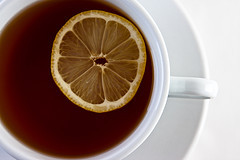Former Teavana Employee Confirms That Workers Brew Misleadingly Strong Store Samples
Last week we heard from a fellow consumer advocate/customer who was disappointed that the Teavana tea she was convinced to buy in the store by its heavenly taste didn’t taste as good once she got it home. She spoke to a worker who said they use more tea in the store samples than the instructions given to customers, and now a former Teavana employee confirms that practice as well. Teagate, anyone?
L. says she was “long one of the disappointed masses,” and admits that one of the reasons she looked forward to working at Teavana was to uncover the mystery of the tea that tastes so good at the store, so she could copy it at home.
She says the discrepancy between the samples in the store and the tea that results from directions given to customers can be pretty extreme. That’s because the in-store tea is way stronger and except for the unflavored oolong, heaped with sugar.
L. shared a typical recipe barista used when there wasn’t already enough samples already brewed. It’s an entirely different recipe, she notes, and often included almost a cup of loose tea per 4-cup container.
The barista recipe for the iced blueberry-pineapple tea sample for a 32-oz brew, to be poured over ice, according to L:
– 1/2 cup Blueberry Bliss rooibos tea
– 1/2 cup Pineapple Kona Pop! herbal tea
– 1/2 cup German Rock Sugar
– Fill teamaker or teapot to the top with boiling water, steep for 15 minutes or longer
By contrast, the customer directions amount to around 2-3 teaspoons of each of those teas and two teaspoons of sugar. Hot samples use less tea she says, and a quarter the sugar, but are brewed stronger and sweeter than the at-home instructions require.
“The chai in question, for instance, called for 1/8 cup of each blend tea, but our baristas often used 1/3 cup each, which is the amount called for in most other sample recipes. There’s a reason they’re so darn tasty!” she adds.
One nice thing L. would do is fill customers in if they did ask for exact instructions to recreate the shop samples.
If I was asked how to brew the tea exactly as it comes in the shop, I would certainly tell the customer, and often write it down for their later reference, but in general the instructions given over the counter are misleading. Even cups of non-sample tea are generally brewed strong and sweet, unless a customer asks otherwise. It’s a little shady, but oftentimes I saw customers returning, either to clarify as the woman in the February 15th story did, or to just give up and buy a cup, so I suppose it worked well enough for the company.
It’s good to know there are baristas out there willing to help out customers, but if the samples represented what you can do at home in the first place, there wouldn’t be such a need for all this explaining. What you taste is what you would get — in a perfect world.
Want more consumer news? Visit our parent organization, Consumer Reports, for the latest on scams, recalls, and other consumer issues.


